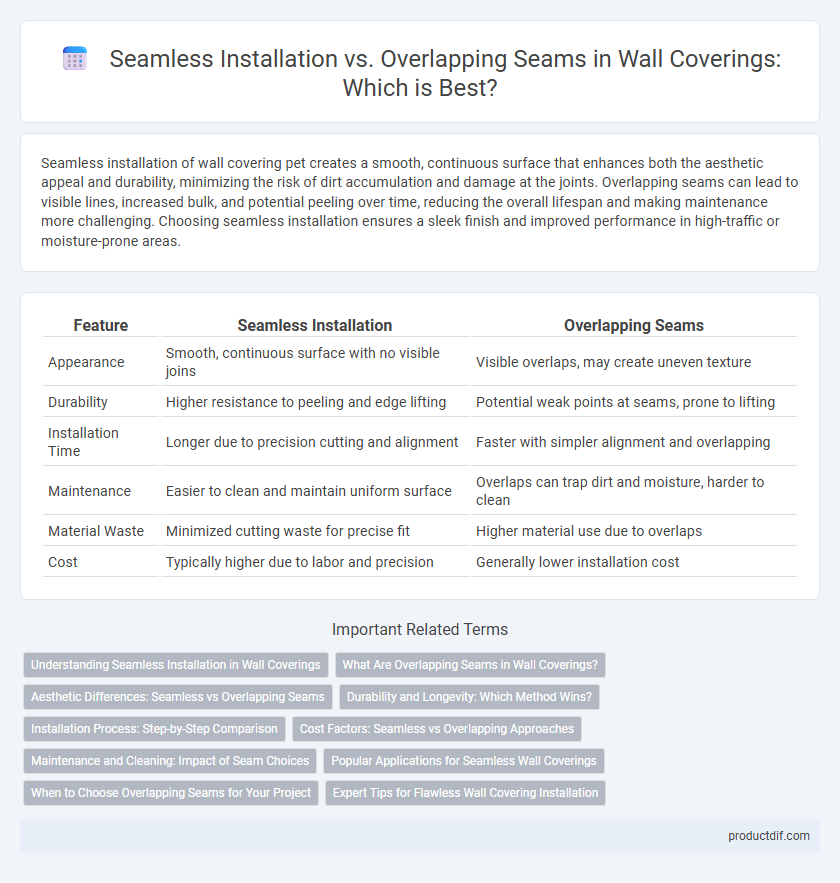Seamless installation of wall covering pet creates a smooth, continuous surface that enhances both the aesthetic appeal and durability, minimizing the risk of dirt accumulation and damage at the joints. Overlapping seams can lead to visible lines, increased bulk, and potential peeling over time, reducing the overall lifespan and making maintenance more challenging. Choosing seamless installation ensures a sleek finish and improved performance in high-traffic or moisture-prone areas.
Table of Comparison
| Feature | Seamless Installation | Overlapping Seams |
|---|---|---|
| Appearance | Smooth, continuous surface with no visible joins | Visible overlaps, may create uneven texture |
| Durability | Higher resistance to peeling and edge lifting | Potential weak points at seams, prone to lifting |
| Installation Time | Longer due to precision cutting and alignment | Faster with simpler alignment and overlapping |
| Maintenance | Easier to clean and maintain uniform surface | Overlaps can trap dirt and moisture, harder to clean |
| Material Waste | Minimized cutting waste for precise fit | Higher material use due to overlaps |
| Cost | Typically higher due to labor and precision | Generally lower installation cost |
Understanding Seamless Installation in Wall Coverings
Seamless installation in wall coverings enhances aesthetic appeal by eliminating visible joints, creating a smooth, continuous surface that appears flawless. This technique requires precise alignment and expert handling to ensure edges blend perfectly, preventing issues like peeling or seam separation common in overlapping seams. Understanding seamless installation emphasizes its benefits in durability, easy maintenance, and a modern, clean finish ideal for high-end interior design projects.
What Are Overlapping Seams in Wall Coverings?
Overlapping seams in wall coverings occur when one strip of material partially covers the edge of the adjacent strip, creating a visible overlap. This method is traditionally used to ensure better adhesion and reduce gaps, but it can result in a less smooth finish compared to seamless installation. Overlapping seams may be more prone to peeling or dirt accumulation along the edges, affecting both aesthetics and durability.
Aesthetic Differences: Seamless vs Overlapping Seams
Seamless installation creates a smooth, uninterrupted surface that enhances the modern aesthetic of walls by eliminating visible joints and promoting a cleaner, more refined look. Overlapping seams, while easier to install, introduce subtle ridges and texture changes that can disrupt visual flow and draw attention to the seams, often resulting in a less polished appearance. Choosing seamless wall coverings is ideal for high-end interiors where a flawless finish and sleek design are paramount.
Durability and Longevity: Which Method Wins?
Seamless installation of wall coverings significantly enhances durability by eliminating weak points where seams could peel or collect dirt, ensuring a smoother and more resilient surface. Overlapping seams, while easier to apply, create vulnerable joints that are prone to wear and may reduce the overall lifespan of the wall covering. For long-term performance and resistance to damage, seamless installation generally outperforms overlapping seams in maintaining structural integrity and appearance.
Installation Process: Step-by-Step Comparison
Seamless installation of wall coverings involves precise measurement and single-panel application, reducing visible joints and creating a smooth, continuous surface. Overlapping seams require careful alignment of adjoining panels with a slight overlap to ensure coverage and prevent gaps, but this process may result in raised edges. The step-by-step process of seamless installation demands meticulous cutting and fitting, while overlapping seams emphasize panel positioning and edge sealing.
Cost Factors: Seamless vs Overlapping Approaches
Seamless wall coverings generally incur higher material and labor costs due to the precision cutting and specialized installation techniques required to avoid visible joins. Overlapping seams often reduce installation time, lowering labor expenses but may increase long-term maintenance costs due to potential peeling or seam separation. Evaluating cost factors depends on project scale, desired aesthetic, and durability expectations, with seamless installations favored for premium finishes despite their upfront investment.
Maintenance and Cleaning: Impact of Seam Choices
Seamless wall coverings minimize dirt and dust accumulation by eliminating gaps where debris can settle, streamlining cleaning and maintenance efforts. Overlapping seams may trap moisture and grime, increasing the risk of mold growth and requiring more frequent inspections and specialized cleaning products. Choosing seamless installation enhances durability and ensures easier upkeep in high-traffic or humid environments.
Popular Applications for Seamless Wall Coverings
Seamless wall coverings are widely favored in settings requiring a sleek, uninterrupted surface such as hospitals, hotels, and corporate offices, where hygiene and aesthetics are crucial. These applications benefit from the smooth, continuous finish that prevents dirt and bacteria buildup, enhancing cleanliness and durability compared to overlapping seams. Industries like healthcare and hospitality prioritize seamless installations for their ease of maintenance and superior visual appeal.
When to Choose Overlapping Seams for Your Project
Overlapping seams are ideal for projects requiring enhanced durability and moisture resistance, particularly in high-traffic or humid environments such as bathrooms and kitchens. This method allows for easier adjustments during installation, accommodating uneven wall surfaces and reducing visible gaps over time. Choosing overlapping seams ensures a more forgiving application process, making it suitable for DIY projects or walls with slight imperfections.
Expert Tips for Flawless Wall Covering Installation
For flawless wall covering installation, seamless techniques offer a sleek, modern finish that eliminates visible lines, enhancing room aesthetics. Overlapping seams provide extra durability and are ideal for textured or patterned wallpapers, ensuring alignment and preventing peeling over time. Experts recommend precise measurements and using a high-quality adhesive to maintain a professional look regardless of the chosen method.
Seamless installation vs Overlapping seams Infographic

 productdif.com
productdif.com